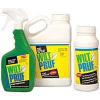Testing and Adjusting Soil pH Levels
Plants require varying degrees of soil acidity and some are very sensitive to soil pH.
So, what does this mean?
The level of acidity or alkalinity of the soil is measured by pH (potential Hydrogen ions). It is a measure of the amount of lime (calcium) in your soil, and the type of soil that you have. Soil in moist climates tends to be acidic and those in dry climates tend to have alkaline. A soil with a pH lower than 7.0 is an acid soil and one with a pH higher than 7.0 is alkaline. The soil must be adjusted to suit the plant which will occupy that area if it is not already within the plants requirement range.
Testing your soil pH
We sell several different types of soil pH testing kits, these kits range from inexpensively to moderately priced. They consist of a test tube, some testing solution and a color chart. You put a sample of your soil in the tube, add a few drops of the test solution, shake it up and leave it for an hour or so to settle. The solution in the tube changes color according to the pH of your soil. Compare the color of your sample with the color chart that came with the kit. Matching colors will tell you the pH of your sample. The better kits will also come with advisory booklets about how to interpret your result.
Adjusting your soil pH
Once you have determined the pH you can amend the soil, if needed to accommodate the plants in your garden using materials commonly available here.
If you need to raise the soil pH to make it more alkaline
It is easier to make the soil more alkaline than it is to make them more acidic. Because different soil types react different ways to the application of lime you will have to add more lime to clay soils and peat soils than you will in sandy soils to achieve the same result.
To raise your pH by 1.0 point and make your soil more alkaline:
-Add 4 ounces of hydrated lime per square yard in sandy soils
-Add 8 ounces of hydrated lime per square yard in loamy soils
-Add 12 ounces of hydrated lime per square yard in clay soils
-Add 25 ounces of hydrated lime per square yard in peat soils
If your soil is over-acidic, you may consider gradually adjusting the soil over a year time period and testing it periodically. You can try adding such components as hardwood ash, bone meal, crushed marble or crushed oyster shells as this will also help to raise the soil pH.
If you need to lower the soil pH to make it more acidic
If your soil needs to be more acidic, sulfur may be used to lower the pH if it is available. To reduce the soil pH by 1.0 point, mix in 1.2 oz. of ground rock sulfur per square yard if the soil is sandy, or 3.6 oz. per square yard for all other soils. The sulfur should be thoroughly mixed into the soil before planting. Sawdust, composted leaves, wood chips, cottonseed meal, leaf mold and especially peat moss will lower the soil pH.
Remember to always read and follow manufacturers label instructions when using chemicals.
-Use appropriate protection such as dust mask and gloves.
-The best way to adjust pH is gradually over several seasons.
-Lime should be applied only when tests show it to be necessary.
-If the soil is excessively alkaline, you may find that you are better off to build a raised bed using fresh, screened topsoil.
-If you are still not sure what to do, please feel free to call us or ask someone at our Customer Service Desk.
Information provided by: The Garden Helper







